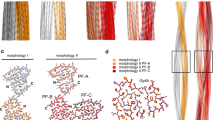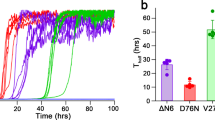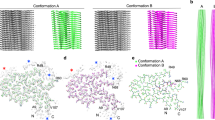Abstract
AMYLOID may be deposited in animal or human connective tissues in a variety of pathological circumstances. It consists mainly of protein, with up to 5 per cent of carbohydrates largely in the form of mucopoly-saccharides. Previous attempts to characterize the protein moiety of amyloid have included : (a) Extraction with strong alkali followed by electrophoresis, revealing either α-1-, β-2-, and β-globulins with traces of albumin1 : or α-globulin alone2 ; (b) Extraction with strong alkali followed by analytical ultra-centrifugation, demonstrating a single component with a sedimentation coefficient of 62 ; (c) Extraction with concentrated aqueous urea followed by analytical ultracentrifugation, showing five fractions with sedimentation coefficients of 1, 6, 9, 16 and 23 (ref. 3); (d) Extraction with strong alkali followed by amino-acid analysis, which gave no precise protein identification but excluded collagen as a significant constituent on the basis of low hydroxyproline values2; (e) Fluorescent protein tracing in histological preparations, which is so sensitive a technique that trace contaminants would be revealed, has detected the presence of γ-globulin4–6, β-1 complement6, rheumatoid factor6, and fibrinogen6; (ƒ) Absorption of specific anti γ-globulin antiserum with purified amyloid substance, which produced no significant reduction in titre7; (g) Extraction with concentrated aqueous urea followed by immuno-diffusion and electrophoresis against specific antisera to albumin, γ-globulin, cæruloplasmin, orosomucoid, β-2 macroglobulin, rheumatoid factor, C-reactive protein, a pool of myeloma globulins, and whole serum ; none of these antisera precipitated the amyloid proteins3; (h) Extraction with strong alkali followed by preparation of an antiserum which, on immuno -electrophoresis against whole serum, gave precipitin arcs in the α-2 regions8. None of these methods has entirely surmounted the two main obstacles to precise identification of the protein components of amyloid. These are, first, the relative insolubility of this material in all but chemically vigorous reagents which are liable to degrade proteins and, secondly, the difficulty in obtaining amyloid free from incidental contamination by plasma proteins. The new method reported here appears to circumvent both these difficulties in the isolation of pure natural amyloid.
This is a preview of subscription content, access via your institution
Access options
Subscribe to this journal
Receive 51 print issues and online access
$199.00 per year
only $3.90 per issue
Buy this article
- Purchase on Springer Link
- Instant access to full article PDF
Prices may be subject to local taxes which are calculated during checkout
Similar content being viewed by others
References
Wagner, B. M., Amer. Med. Assoc. Arch. Path., 60, 221 (1955).
Calkins, E., and Cohen, A. S., J. Clin. Invest., 37, 882 (1958).
Benditt, E. P., Lagunoff, D., Eriksen, N., and Iseri, O. A., Amer. Med. Assoc. Arch. Path., 74, 323 (1962).
Mellors, R. C., and Ortega, L. G., Amer. J. Path., 32, 455 (1956).
Vasquez, J. J., and Dixon, F. J., J. Exp. Med., 104, 727 (1956).
Lachman, P. J., Muller-Eberhard, H. J., Kunkel, H. G., and Paronetto, F., J. Exp. Med., 115, 63 (1962).
Calkins, E., Cohen, A. S., and Gitlin, D., Fed. Proc., 17, 431 (1958).
Cagli, V., Carbonara, A., and Mancini, G., Boll. Soc. Ital. Biol. Sper., 38, 353 (1962).
Gell, P. G. H., and Coombs, R. R. A., Clinical Aspects of Immunology, 8 (Blackwell Sci. Publ., Oxford, 1963).
Letterer, E., J. Path. Bact., 61, 496 (1949).
Author information
Authors and Affiliations
Rights and permissions
About this article
Cite this article
MUCKLE, T. Protein Components of Amyloid. Nature 203, 773–774 (1964). https://doi.org/10.1038/203773a0
Published:
Issue Date:
DOI: https://doi.org/10.1038/203773a0
This article is cited by
-
Observations on the basophilia of amyloids
Histochemie (1967)
Comments
By submitting a comment you agree to abide by our Terms and Community Guidelines. If you find something abusive or that does not comply with our terms or guidelines please flag it as inappropriate.



